Deborah Luster: One Big Self
by The Kitchen Sisters, npr
“My mom… It’s hard to talk about your mom. She was very glamorous but she never put on any airs. There was no saditty with her. She was infected with that southern ancestor worship thing, all into the arts of dress and manners and home and the table, conversation and story telling. She was a shutterbug.”
IN OUR FAMILY,THE CAMERA WAS MANNED BY A WOMAN”
“Deborah Luster’s mother and father divorced when she was a baby and she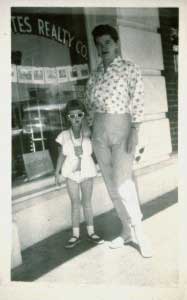 went to live with her grandparents in Arkansas. She and her mom communicated through photographs. “If I got a new coat I would have to be photographed and usually I didn’t want to be photographed so it would be the back of the coat. There would be photographs of me and my cat, my grandfather and me.”
went to live with her grandparents in Arkansas. She and her mom communicated through photographs. “If I got a new coat I would have to be photographed and usually I didn’t want to be photographed so it would be the back of the coat. There would be photographs of me and my cat, my grandfather and me.”
From her mother, Deborah would receive posed photographs. “She would dress up even when she was cooking. Designer clothes and high heels. I mean, she’d wear a mink coat to a tractor pull, think nothing of it. Red hair. Big glamourpuss.”
APRIL 1, 1988
On April 1, April Fools Day, 1988, Deborah’s mother was murdered in her bed by a contract killer who came in through her kitchen window, down her hall and shot her five times in the head. Deborah believed she had seen the man at one time so she reasoned that he might be after her as well. For seven years she lived in terror until they arrested the man and he was tried and convicted. They have never, however, caught the person who hired her mother’s killer.
After her mother’s death Deborah started to photograph. “My mom had photographed constantly, my grandmother had photographed and constantly documented our family. Photography became something that I could think to do to try to dig out of the place I had found myself.”
“Perhaps I was channeling my ancestors in the years following the deaths of my mother and grandmother. Perhaps it was their spirits that moved me to pick up a camera—for in our family, the camera was manned by women. It was my turn. Or perhaps I picked up the camera out of desperation. I did need a tool. I was buried under the loss of my family members. The world was a sinister one. I was awake and numb and frightened. How could I sleep under the same stars as my mother’s murderer? I used the camera to dig out. I found that I was still capable of making contact.”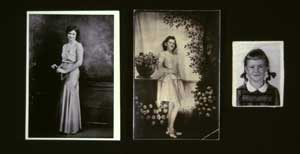
THERE SEEMED TO BE A LOT OF PRISONS
Deborah had moved to Monroe in northern Louisiana. In 1998 she was sent out with other photographers by The Louisiana Endowment for the Humanities to photograph in the region in support of an empowerment zone application for the state’s very impoverished.
“Debbie started noticing that the landscape was fairly emptied out,” remembered poet C.D. Wright, Deborah’s friend and collaborator. “Then she noticed that it was fairly emptied out but for the fact that there seemed to be a lot of prisons. And she thought, ‘well maybe that’s where everybody is.” Which, in fact, is where everybody is.”
On a Sunday afternoon Deborah knocked on the gates of a small prison on the banks of the Tensas River. The warden came out and she asked if she might photograph some of the inmates there. He said yes.
“I photographed there once and realized it was a project I had been looking for for a long time, something in response to the murder of my mother,” said Deborah. “It was like it lifted when I went in through the gates it became something else.”
I CAME TO PHOTOGRAPH THAT PERSON, NOT THAT PERSON IN PRISON
Deborah got entrance to the women’s prison in St. Gabriel, the minimum security male prison in Transylvania and Angola Maximum Security prison in Louisiana. She teamed up with her long time collaborator, C.D. Wright and the two began working together on the project.
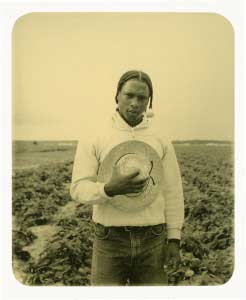 Deborah started taking very straightforward formal portraits. “I would say to the prisoners, you’re an invisible population, and this is your opportunity to show the world who you are, to present yourself to the world as you would be seen. One man went in and came back out and he had written the world “freedom” on a piece of notebook paper.”
Deborah started taking very straightforward formal portraits. “I would say to the prisoners, you’re an invisible population, and this is your opportunity to show the world who you are, to present yourself to the world as you would be seen. One man went in and came back out and he had written the world “freedom” on a piece of notebook paper.”
For the most part, the inmates posed themselves. They might want to hold something like a box of valentine candy or a family photo. One woman wanted to hold her shoe.
Deborah would take in a few pieces of black velvet and some duct tape, find a place that had good light and tape up her backdrop. She didn’t want any sort of sign of prison life. “I didn’t want that to get in the way of the person I was photographing. What I came to photograph was that person, not that person in prison.” “I was trying to photograph as many inmates as I possibly could, because I wanted to really show the numbers of people who are incarcerated, to try to communicate to some degree, just how many of our population reside in prisons.”
At Angola, Deborah photographed prisoners in the cotton fields where they still pick cotton by hand. While Deborah photographed, CD Wright would interview and observe. One poem she wrote was inspired by overheard conversations on the field line—an entry level job at Angola State Penitentiary where prison farm laborers make about eight cents an hour.
“IN LOUISIANA EVERYTHING FEELS LIKE A COSTUME…”
Deborah photographed the women at their Mardi Gras celebration and at the Halloween haunted house at at San Gabriel women’s prison. “There were all of these traditional Louisiana costumes and archetypes,” said Deborah. “Alligator Girl, Rat Face. They run this haunted house in the gymnasium. There’s the snake room, the bird room, the bat room. And there’s the execution chamber where one inmate sits in an electric chair, and the other inmate is the executioner, and she throws a switch, and this strobe light goes on behind the head of the woman that’s supposedly being executed, and that woman starts jumping around. There’s a lot of black humor there.”
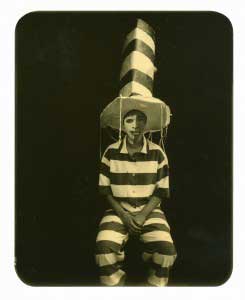 The women make their costumes out of sheets, table clothes and available materials. “The winning costumes were big striped uniforms,” said CD Wright. “Uniforms with big tall Dr. Seuss like striped hats. They were made from uniforms of the women in maximum security who could not participate in either Halloween or Mardi Gras. So those were made in their honor.”
The women make their costumes out of sheets, table clothes and available materials. “The winning costumes were big striped uniforms,” said CD Wright. “Uniforms with big tall Dr. Seuss like striped hats. They were made from uniforms of the women in maximum security who could not participate in either Halloween or Mardi Gras. So those were made in their honor.”
“In Louisiana, everything feels like a costume,” said CD Wright. “The inmates had different uniforms for all of the different positions in the prison. The prisoners were identified by their work detail uniforms. People in culinary arts wore big baker hats and white jackets.
“This man who is scarred so badly, we heard that his brother threw a tire over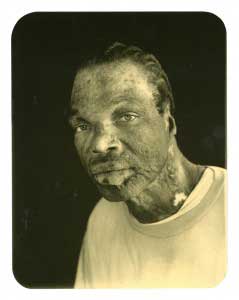 his head and set it on fire,” explained CD Wright. “He was so dignified. He was beautiful, really. He had green eyes. He always looked absolutely, directly at the camera. I found him very striking. Not just because he was so scarred, but because of the dignity he brought to his very disfigured face.”
his head and set it on fire,” explained CD Wright. “He was so dignified. He was beautiful, really. He had green eyes. He always looked absolutely, directly at the camera. I found him very striking. Not just because he was so scarred, but because of the dignity he brought to his very disfigured face.”
The photographs are done on aluminum photographic plates reminiscent of tintypes. The aluminum is treated with gelatin silver as you would treat a canvas with gesso before you paint on it. Deborah makes paper copies of the aluminum plates for the prisoners. They are not allowed to have sharp metal objects. The photographs are small, only a little larger than a postcard. “I wanted to preserve the intimacy of these very formal photographs,” Deborah said.
THEY MADE THEMSELVES SO VULNERABLE TO ME
At Angola where 90 percent of the men that go there, die there, it was very sober. There was no clowning around. It was a very formal. The way they would pose themselves was very sort of nineteenth century.
“For the most part they presented themselves as they wanted to be presented, looking out,” said CD Wright. It as was all voluntary. She returned a portion of the funds that she received from selling the plates which are on aluminum to the prisoners fund. With which they buy popcorn and books and undershirts and personal items.
Deborah made prints for each person she photographed. She returned 25,000 prints to inmates.
At one point Deborah was walking down the block at Angola, in the middle of the 18,000-acre prison, near one of the dormitories there. And a voice behind her said, “You’ve been to the women’s prison at St. Gabriel, haven’t you?” And she said, “Now how would you know that?” And the man said, “Because I sent my girlfriend a picture you took of me, and she sent me one back just like it.” “So there were these little images are flying between the prisons,” said Deborah, ” and, I thought that’s what it was all about.”
“They made themselves so vulnerable to me and it’s not often that you have an encounter like that. I know a lot of it was that they were actually posing for the people that they loved, their husbands, their wives, their children.”
“There was a woman who asked to be photographed,” said Deborah. “She said ‘I’ve been here 15 years. I’m down for 99 years. I have 19 children. My children haven’t spoken to me since I came to prison. Perhaps if I had some photographs I could send them it would soften their hearts to me.’ A few months later she said, ‘Four of my children came to visit me. The baby came and he’s nineteen. He was five years old when I came to prison.’”
SOMETHING MY MOTHER WOULD HAVE DONE
“For me,” said Deborah. “It became this project about the importance of the personal photograph, and what that little slip of paper, or piece of tin can mean to a person.”
“I think this project is the kind of thing my mother would have done,” said Deborah. “She had this way of looking right through the veneer, right into people. She could see the bottom in people. She liked to photograph her family, the food on your plate, you brushing your teeth. She photographed what she loved and that’s what she loved.”
